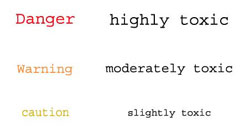Pesticide labels provide information for applicator personal safety, safety to others and instructions on safe use to protect the environment. The label is the law, so READ THE LABEL BEFORE USING and make sure you understand it! In addition to directions on how to use it, it contains information on storage, transport, mixing, loading, disposal, and equipment cleaning. All these activities carry a risk of exposure and safety precautions should be taken. The risk of using a pesticide is based on its toxicity level and the amount of the person’s exposure. To minimize risk when using pesticides, use the least toxic pesticide option available and reduce exposure to yourself by using personal protective equipment, often referred to as PPE.

Signal words are written on every pesticide label to indicate the pesticide potential to make you sick, or the relative toxicity to the user. The signal word is important as a toxicity indicator, but the route and length of exposure are other factors that also impact the risk of any pesticide.
CAUTION is the signal word for pesticides that are slightly toxic, and indicates two or more tablespoons are lethal.
WARNING is the signal word for pesticides that are moderately toxic. This signal word indicates it would take one teaspoon to two tablespoons to be lethal.
DANGER is the signal word for highly hazardous pesticides. When this word appears on the label, it indicates the pesticide is so highly toxic that only a few drops to one teaspoon full ingested orally is lethal to a human. They can also severely burn your skin and eyes.
Humans can be exposed to pesticides one of three main ways: dermal adsorption (skin, eyes), oral ingestion (swallowing), or inhalation (breathing). PPE is the main way that pesticide applicators, mixers, and handlers reduce potential exposure to pesticides. PPE requirements are always listed on the pesticide label and may include (but are not limited to): chemical-resistant gloves, long-sleeve shirt, pants, respirator, and protective glasses. PPE requirements are often dependent on pesticide toxicity and formulation type (liquid, granular, aerosol, etc.).
When working with or near pesticides, frequently wash your hands and face using soapy water, especially before you use the restroom, eat or smoke. When you are done working with pesticides for the shift or day, leave your boots outside of your household. Take a shower, washing all areas of your body including your hair, and put on clean clothes before relaxing and interacting with the family.
Keep pesticide-contaminated clothing separate from regular laundry. It should be washed separately from the rest of the laundry using detergent, the hottest temperature setting, and the setting for heavily-soiled laundry. If your clothes and/or boots are highly contaminated, dispose of them.
Pesticide labels contain safety information and other valuable information you must read and understand before using any product. The law requires you to abide by the pesticide label instructions and following instructions will help minimize overall risk to you and the environment.
For more information, see the following Planttalk
Colorado™ script(s).



